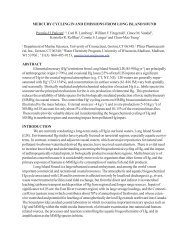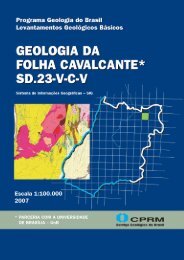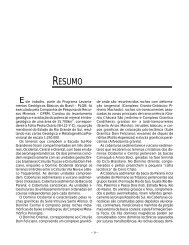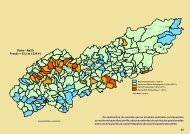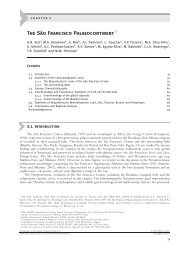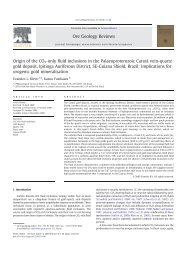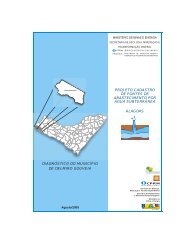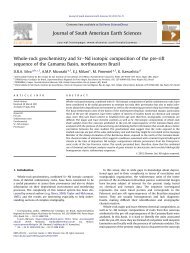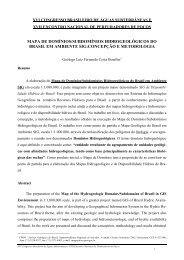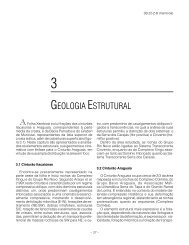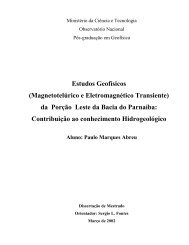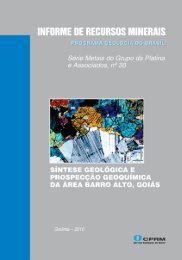geologia e recursos minerais da folha eldorado paulista sg ... - CPRM
geologia e recursos minerais da folha eldorado paulista sg ... - CPRM
geologia e recursos minerais da folha eldorado paulista sg ... - CPRM
Create successful ePaper yourself
Turn your PDF publications into a flip-book with our unique Google optimized e-Paper software.
Geologia e Recursos Minerais <strong>da</strong> Folha Eldorado Paulista<br />
ABSTRACT<br />
The Eldorado Paulista Sheet (SG.22-X-B-VI) comprises part of the states of São Paulo<br />
and Paraná, southeastern Brazil. It is bounded by longitudes 48 o 30’W and 48 o 00’W<br />
and latitudes 24 o 30’S and 25 o 00’S. Geologic mapping at 1:100,000 scale allowed<br />
for a substantive reformulation of the regional stratigraphy with refinement of<br />
previously defined units and mapping of new units. The geolocial units are related<br />
with the terranes (or tectonic domains) Apiaí, Curitiba, Paranaguá and Luís Alves.<br />
The first three are segments of the southeastern Ribeira Belt (Mantiqueira Province),<br />
while the latter represents a cratonic fragment did not affect by the Brasiliano-Pan<br />
African Orogeny.<br />
The Apiaí Terrane is dominated by supracrustal rock sequences including<br />
metavolcanosedimentary and metasedimentary rock units metamorphosed<br />
under lower greenschist to amphibolite facies conditions included in the Açungui<br />
Supergroup, considered as a composite terrane. The Açungui Supergroup is divided<br />
into two units, with internal subdivisions: (i) the Votuverava Group (ca. 1450-1480<br />
Ma), composed of rhythmic metapelites (slate and phyllite) with intercalations of<br />
basic metavolcanic rocks, lenses of quartzite and calc-silicated rocks, subdivided<br />
into the Nhunguara, the Piririca, the Rubuquara and the Ribeirão <strong>da</strong>s Pedras<br />
formations; (ii) the Serra <strong>da</strong>s Andorinhas Sequence (Calymmian?), composed of<br />
rhythmic phyllite and micaschist, marble and calc-silicatic rocks, subdivided into a<br />
metapelitic unit and the Tapagem Marble.<br />
The Curitiba Terrane is composed of basement rocks of the Barra do Azeite Banded<br />
Gneiss (Atuba Complex) and supracrustal sequences of the Capiru and Turvo-Cajati<br />
formations. The Barra do Azeite Banded Gneiss (ca. 2200-2100 Ma) is composed<br />
of banded orthogneiss migmatized under upper amphibolite facies conditions and<br />
mylonitized under greenschist facies conditions. The Capiru Formation, maximum<br />
age of sedimentation of ca. 800-850 Ma, is composed of siliciclastic and carbonate<br />
metasedimentary rocks, metamorphosed under lower greenschist facies conditions.<br />
The Turvo-Cajati Formation, with maximum age of sedimentation of ca. 850-900 Ma,<br />
is composed of siliciclastic and carbonate metasedimentary rocks metamorphosed<br />
under greenschist to granulite facies conditions. It is subdivided into a phyllite unit<br />
(rhythmic phyllite and slate – metasiltstone, meta-argillite and metasandstone),<br />
a micaschist unit (coarse-grained micaschist with garnet and locally staurolite<br />
and kyanite) and a paragneiss unit (sillimanite-garnet paragneiss, coarse-grained<br />
anatetic micaschist and locally kyanite-garnet paragneiss). The Curitiba Terrane<br />
also includes two volcanosedimentary basins of Proterozoic-Fanerozoic transition,<br />
related with shear zones (In<strong>da</strong>iatuba and Quatis formations).<br />
The Luís Alves Terrane is formed by the Serra Negra Complex, of Archean to<br />
Paleoproterozoic age, the oldest unit of the Eldorado Paulista Sheet, and by<br />
supracrustal rocks of the Rio <strong>da</strong>s Minas Formation. The Serra Negra Complex is<br />
composed primarily of gneissic-granulitic rocks of basic to intermediate composition<br />
(gabbroids, tonalite, granodiorite) preserved or partially retrometamorphosed<br />
under upper greenschist to amphibolite facies conditions. The Rio <strong>da</strong>s Minas<br />
Formation (redefinition of the Cachoeira Sequence) is composed of siliciclastic<br />
metasedimentary rocks metamorphosed under lower greenschist to upper<br />
amphibolite facies conditions. It is subdivided into a unit of slate and phyllite,<br />
a micaschist unit and a paragneiss unit. The presence of lenses of ultramafic<br />
XI



